Guide to biosecurity measures to keep pigs disease-free
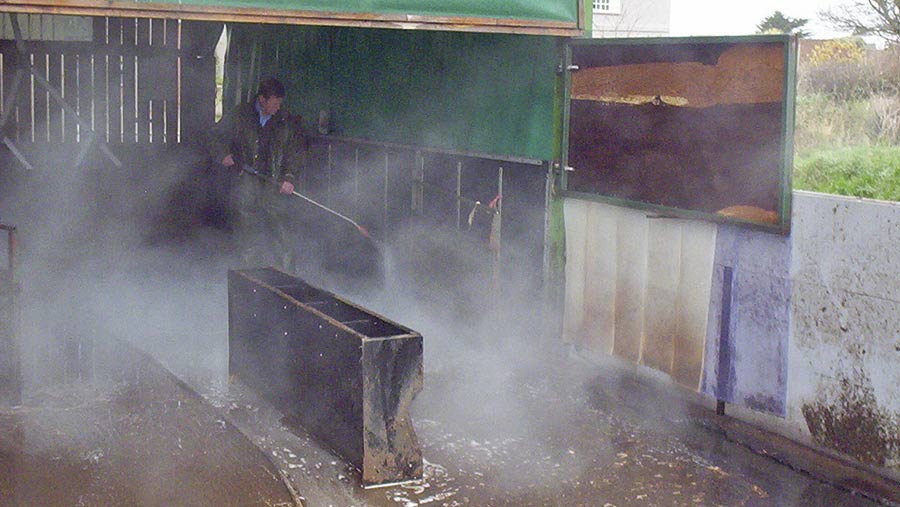
Cleaning and disinfection programmes need to be stepped up on many pig farms to tackle residual disease reservoirs, according to vets, researchers and AHDB Pork experts.
Feed, rodents, birds and transport are all commonly blamed vectors for disease. But the residual disease reservoir, left over from previous batches within the unit, remains an area that is often underestimated as a major source of infection.
Research work carried out in Germany, found diseases such as salmonella persisted for weeks in pockets of dust, even on units that had carried out cleaning and disinfection.
See also: 6 energy efficiency tips for pig farmers
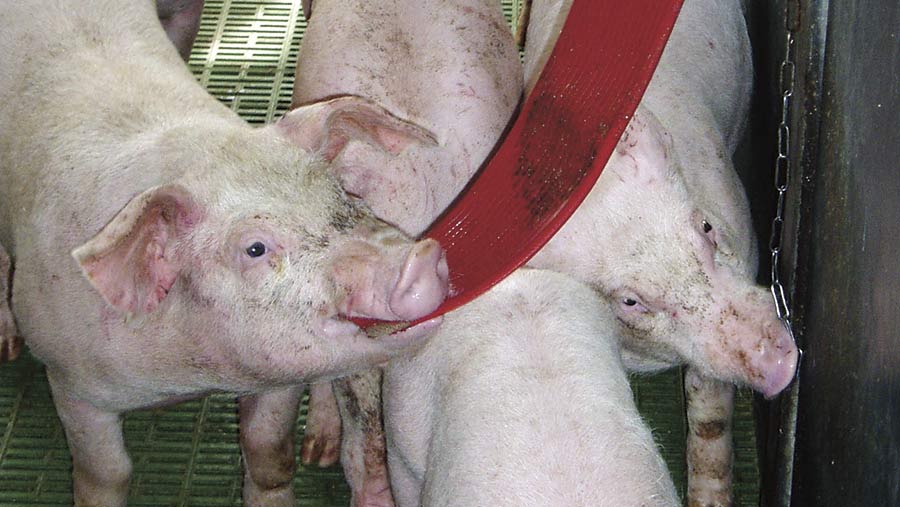
Everything the pigs come into contact with should be cleaned and disinfected
The research, carried out by Professor Thomas Blaha at the University of Veterinary Medicine, Hannover, sampled areas in pig units and found even after cleaning, dust lurked in areas hidden from view such as ventilation inlets and fan housings.
Newly introduced pig batches were then showered with salmonella bacteria as soon as the ventilation was switched on.
Bugs persisted in significant numbers even in areas where the farmers believed cleaning had been carried out (see “Salmonella-positive samples in areas in direct contact with pigs”).
The university’s research also revealed the extent that pathogens spread and grew to be present in high percentages even in stores, passageways and staff offices.
It showed how simply overlooking some areas such as passageways, store rooms and clothing was creating a cycle of reinfection that undermined production performance.
Salmonella-positive samples in areas in direct contact with pigs
- Pen walls 28%
- Feeders and troughs 27%
- Drinking nipples 27%
- Pig toys 21%
Salmonella-positive samples in areas not in direct contact with pigs
- Central walkways 32%
- Shoes/boots 25%
- Anterooms 25%
Source: University of Veterinary Medicine Hannover, Foundation
Cleaning and disinfection
The research shows that a cleaning and disinfection regime is critical to a disease elimination strategy, not just salmonella but others like porcine epidemic diarrhoea virus (PEDv).
According to advice produced by AHDB Pork, an effective regime should be made up of a preparation phase, followed by a five-stage cleaning and disinfect programme.
- Remove organic matter
- Apply detergent/degreaser
- Clean
- Disinfect
- Rest
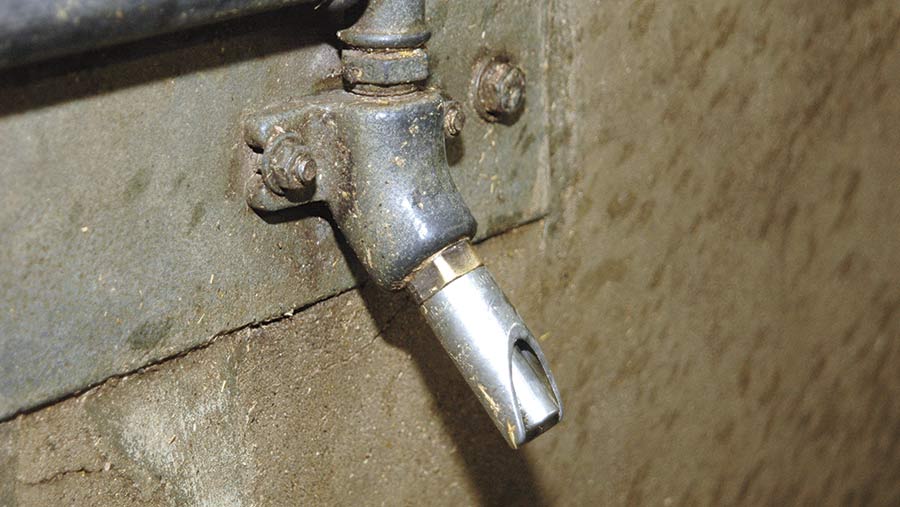
Make sure all drinking points are thoroughly cleaned
Pre-cleaning preparation
Planning the cleaning and disinfection procedure so there is no need to re-enter the cleaned building or rooms before restocking will cut the risk of reintroducing pathogens.
Careful preparation ahead of the cleaning stages can help to expose all surfaces where diseases can lurk.
Removing fixtures and fittings such as suspended heaters, bowls, scales, tools and boards gives the cleaning team better access and therefore also the opportunity to be more thorough.
Cleaning programme
1. Organic matter removal
This stage is critical because organic matter provides an ideal substrate for pathogens and bacteria to thrive. High pathogen concentrations can even overcome the active ingredient in disinfectants, so any organic material left represents a persistent threat to herd health.
It means all manure and bedding must be scraped out and removed from the buildings, while slurry pits should be emptied.
Old feed is another significant risk that can be overlooked, so lines, augers, hoppers and troughs should be emptied and, where possible, dismantled for thorough cleaning.
It is advisable to bag up the first 50kg of feed that remains in the auger because any that may have been exposed to the pigs could harbour bacteria.
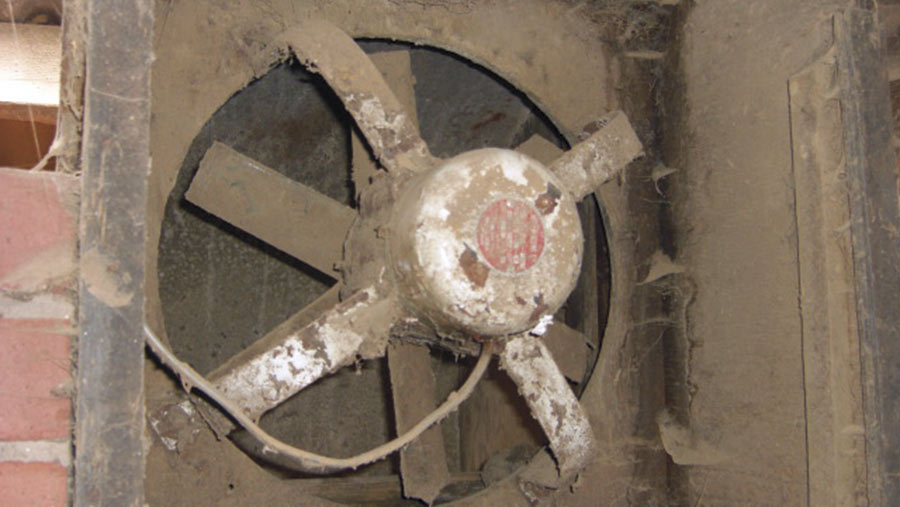
Areas such as fans where pathogens can lodge need special attention
Away from the pigs, as German research showed, there are a number of areas that need attention.
Freezers, fridges and medicine stores should be cleaned and disinfected. Passageways and anterooms should be cleaned out and worker overalls and protective clothing thrown away.
Boots should either be discarded or thoroughly brushed, washed and soaked in appropriate disinfectant at the correct concentration, then allowed to dry.
Once this stage has been completed, a thorough inspection of the work should be carried out to ensure there is no organic material left anywhere on the unit, including loading bays, tracks and yards.
2. Detergent/degreaser application
Detergents or degreasers break down dirt, fats and oils that would otherwise form a barrier to water and disinfectant cleaning agents.
Ceilings, walls, floors, curtains and any fixed equipment should first be soaked with cold water. Then a carefully chosen detergent that is specific for use in livestock housing can be applied at the precise dose rate and calibration set out on the label. Failure to adhere to the dose rate may undermine the cleaning process and could endanger staff.
The aim of applying the detergent is to get a deep, uniform coating, so it is recommended to apply it at low pressure using a foamer head.
Once it is applied, detergent must be left to soak in for a minimum of two hours, but preferably overnight.
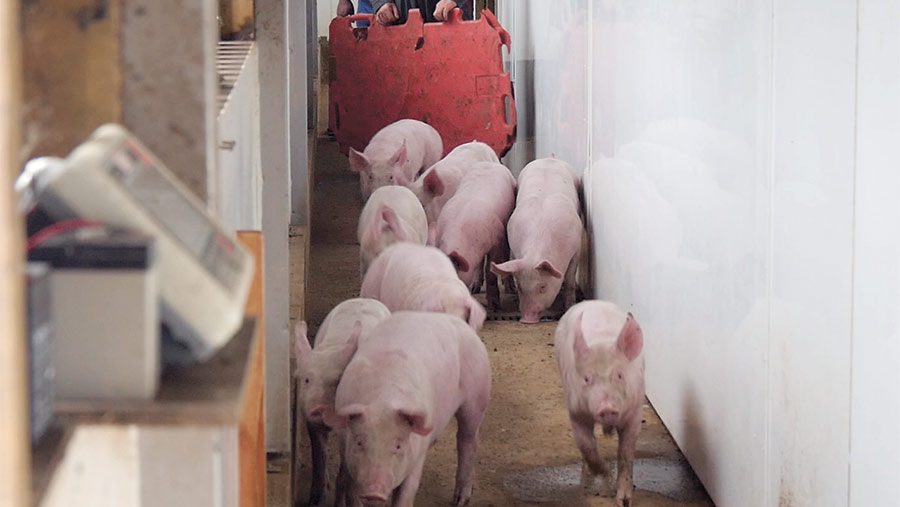
Pathogens are often found in areas such as passageways
3. Cleaning and drying
AHDB advice insists thorough cleaning is the key to the removal of most pathogens, with disinfectant providing added protection.
It advises that 99% of pathogens are removed by cleaning and the remaining 1% by the following disinfectant.
It also says pressure washers should be supplied with clean – not recycled – water to limit the risk of introducing pathogens.
Ideally water should be heated above 70C, making it a more effective cleaning agent. Washing should then start from the ceiling, working down to the walls, pen sides and floors, otherwise contaminated water could run down and reinfect the lower areas.
Areas where pathogens can lodge, such as corners, drinking points, pipelines, slats, fans and ventilation ducts, all need particular focus to ensure they are clean.
Any areas that could be damaged by pressurised water, such as creep lamps, heaters and light fittings, need to be cleaned and disinfected by hand.
Only when areas are inspected and deemed completely clean is the task complete.
Any water that has collected in slurry pits should be drained and the pits cleaned along with all water systems and header tanks.
Once this has been completed, the area must be allowed to dry completely, because any pockets of remaining moisture will provide a good environment for bugs to survive.
Moisture will also dilute and reduce the disinfectant, applied in the next stage.
4. Disinfection
Disinfectants vary in their actions and can be pathogen-specific, so it is important to consult the farm vet on which types are appropriate for the unit.
Aspects like the compatibility with detergents and efficacy in different areas of the farm may mean more than one disinfectant type is needed. Once the choice is made, it is imperative to follow the recommended dilutions and application rates and make sure staff understand the safety instructions.
As with detergents, disinfectant should be applied from the ceiling downwards, with all tight areas, ledges, corners, fan casings and inlets soaked carefully. All broad surfaces, drinking points and feeding equipment should also be coated.
Knapsack sprayers are ideal because they apply products at low pressure and are designed to resist the corrosive effect of the disinfectant which can cause damage to some pressure washers.
For water systems, dilutions must be adhered to and the disinfectant left in pipes and tanks for the length of time recommended by the manufacturer. If you have doubts about which disinfectant to use, contact your vet.
Approved concentrations can be found on Defra’s website.
5. Drying
Pathogens survive in moist conditions, so allowing drying time is a crucial part of the cleaning regime. Once the operations have been completed and checks show the unit is clean, the whole treated area should be left to dry for at least 24 hours.
Using extra heat sources will further reduce the pathogens’ survivability, especially if temperatures can be raised to 70C for at least 10 minutes. Rooms should be left for five to seven days before restocking.
Boot dip disinfectants are crucial to beat disease
With the houses thoroughly cleaned, it is equally important to ensure bugs are kept out using disinfectant boot dips at every access point.
However, failing to use the right disinfectant at the correct dilution rate for boot dips could leave pig farms exposed to disease.
An Animal and Plant Health Agency trial, which covered a wide range of active ingredients, compared their use in boot dips at different dose rates and then added organic matter to mimic farm conditions.
APHA research scientist Becky Gosling says the recommended procedure is to change dips twice a week and to stick to dose rates.
The APHA trial compared dips with half the recommended dose rate and the correct concentration.
Researchers then added pig faeces to the solutions each day to represent boot dipping before comparing how well the disinfectant worked against a target bug, salmonella.
“At the half-dose rate most of the products failed to kill the salmonella bacteria. So there is a clear message that if you don’t follow guideline rates, you are potentially exposing your animals to disease,” warns Dr Gosling.
There was also a discrepancy in how well the different products worked. The worst performers were peracetic acid-based products.
These products struggled to cope with the organic matter and generally failed to kill salmonella by the third day.
“Where these products are used it is imperative to change the dips every two days and ensure they are used at the recommended rate,” Dr Gosling added.
The products that worked best were:
- Glutaraldehyde
- Glutaraldehyde/formaldehyde
- Chlorocresol peroxomonosulphate
These product types coped well with very little salmonella growth found.
Of these, chlorocresol remained stable and effective for the longest period.
Boot dip advice
- Change boot dips twice a week
- Change peracetic acid every two days
- Use lidded container to keep out rain
- Remove muck before dipping, using brush
- Change boots at each house
Pig diseases A-Z
Check out the Pig Health tool from Pig Progress. It can help you identify, prevent and treat a huge range of pig diseases and health issues. Find a disease now.
